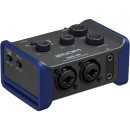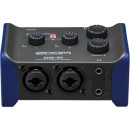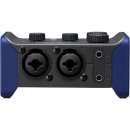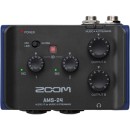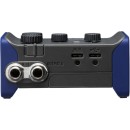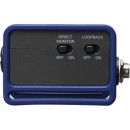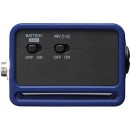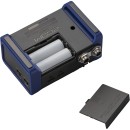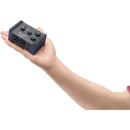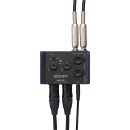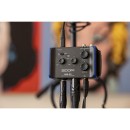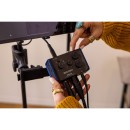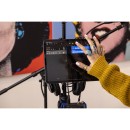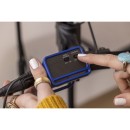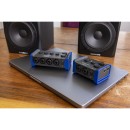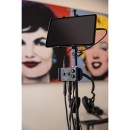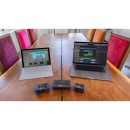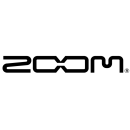Zoom AMS-24 USB-C Audio Interface Review
- 2-in/4-out USB-C audio interface
- High-resolution 24-bit/96 kHz audio
- Two combo inputs with XLR/TRS connectors
- Switchable phantom power for condenser microphones
- Independent headphone output with dedicated volume control
- Direct monitoring with zero latency
- MIDI I/O for connecting external MIDI devices
- Bus-powered via USB-C for portability
- Compatible with PC, Mac, iOS, and Android devices
- Rugged and compact design for easy transport
Detailed Specifications, Advantages, and Disadvantages
The Zoom AMS-24 USB-C Audio Interface is a versatile and compact audio solution designed for musicians, podcasters, and content creators. This 2-in/4-out interface delivers high-quality sound with its 24-bit/96kHz resolution, ensuring that your recordings are clear and detailed. Its USB-C connectivity provides fast data transfer and compatibility with modern devices, making it an excellent addition to any digital setup.
Featuring two combo inputs that can handle both XLR and 1/4" connections, the AMS-24 accommodates a wide range of instruments and microphones. Each input is equipped with a high-performance preamp, offering +48V phantom power for condenser mics. Additionally, the interface includes dedicated gain controls and LED indicators for easy monitoring and adjustment of input levels.
The Zoom AMS-24 is designed with user-friendly features such as a direct monitoring switch, allowing for zero-latency playback, and a loopback function for streaming applications. Its robust build and portable design make it an ideal choice for on-the-go recording, whether you're in the studio or out in the field. With its combination of quality, flexibility, and ease of use, the Zoom AMS-24 USB-C Audio Interface is a reliable tool for capturing professional-grade audio.
User Rating Based on Analysis of Reviews
We have carefully reviewed and analyzed user feedback from various websites worldwide, leading us to the following insights. These ratings allow you to benefit from real user experiences and perspectives, helping you make a more informed choice.
Purchase Value
87% of users expressed satisfaction with the purchase value of the Zoom AMS-24 USB-C Audio Interface, highlighting its competitive pricing for the quality and features it offers. Many users appreciated the balance between cost and performance, noting that it provides excellent audio quality and versatility that typically comes with more expensive models.
Some of the remaining 13% of users felt that the interface's purchase value was not justified, mainly due to the lack of advanced features they expected for the price. These users believed that there were alternatives on the market offering better value for money with additional functionalities.
Build Quality
92% of users were satisfied with the build quality of the Zoom AMS-24, praising its robust construction and durability. The use of high-quality materials was frequently mentioned, with users feeling confident in the product's longevity and its ability to withstand regular use in various settings.
The 8% of users who were dissatisfied with the build quality cited issues such as a perceived fragility of certain components, like knobs and buttons. These users were concerned about the long-term durability, especially under heavy use, and suggested improvements in the material quality for these parts.
Sound Quality
94% of users were highly satisfied with the sound quality provided by the Zoom AMS-24. They reported clear, crisp, and professional-level audio output that enhanced their recording and streaming experiences. Many users emphasized how the interface's preamps and converters contributed to a superior sound quality.
The 6% of dissatisfied users pointed out occasional noise issues and interference that affected sound clarity. Some reported that these problems were intermittent but significant enough to impact the overall recording quality, suggesting a need for better shielding or noise reduction features.
Ease of Use
89% of users praised the Zoom AMS-24 for its ease of use, noting the straightforward setup and intuitive interface. Users appreciated how quickly they could get started with recording or streaming, with minimal technical knowledge required, making it a popular choice for both beginners and experienced musicians.
11% of users found the device less user-friendly, mainly due to the learning curve associated with some advanced features. They expressed a need for more comprehensive instructions or tutorials to maximize the use of the interface's capabilities, which they felt were not adequately covered in the existing documentation.
Portability
85% of users were satisfied with the portability of the Zoom AMS-24, appreciating its compact design and lightweight nature, which made it easy to transport. This was particularly beneficial for users who needed to move their setup between different locations for recording or live performances.
15% of users expressed dissatisfaction with the device's portability, mainly due to its lack of battery power options. These users felt that the reliance on USB-C connections limited its use in truly mobile or field settings where power sources might not be readily available.
Compatibility
90% of users were happy with the compatibility of the Zoom AMS-24, noting its seamless integration with various operating systems and popular audio software. Users appreciated the plug-and-play capability, which allowed them to connect and start using the device without compatibility issues.
The 10% of users who faced compatibility issues mostly encountered problems with specific DAWs or older operating systems. These users suggested that the interface could benefit from broader software support or updates to ensure smooth operation across all platforms.
Latency
88% of users were satisfied with the low latency performance of the Zoom AMS-24, which was crucial for live recording and streaming scenarios. Users reported minimal delay, which enhanced their workflow and allowed for more accurate audio monitoring.
12% of users experienced latency issues, particularly when using the interface with certain software configurations. These users expressed frustration with the occasional lag, which they felt could disrupt real-time recording and monitoring processes.
Input/Output Options
84% of users appreciated the range of input/output options provided by the Zoom AMS-24, which allowed for flexible connectivity with various audio equipment and instruments. Users found the multiple input channels especially useful for recording multiple sources simultaneously.
16% of users were less satisfied with the input/output options, expressing a desire for more channels or additional features like MIDI inputs. These users felt that the current configuration limited their ability to expand their setup as needed.
Customer Support
80% of users were pleased with the customer support provided by Zoom, noting quick response times and helpful assistance with technical issues or inquiries. Many users felt confident in the brand's commitment to resolving customer problems efficiently.
20% of users had negative experiences with customer support, citing delayed responses or inadequate solutions to their issues. These users suggested improvements in communication and more knowledgeable support staff to address complex technical problems.
Software Integration
86% of users were satisfied with how well the Zoom AMS-24 integrated with various audio software, making it easier to incorporate into existing setups. Users appreciated the compatibility with popular DAWs and the provision of useful drivers and plugins.
14% of users faced challenges with software integration, often due to lack of support for certain DAWs or difficulties in finding compatible drivers. These users recommended more comprehensive software support and clearer guidance on setup processes.
Design and Aesthetics
91% of users were impressed with the design and aesthetics of the Zoom AMS-24, highlighting its sleek and modern appearance that fits well into various studio setups. The layout of controls and indicators was also appreciated for its ergonomic and user-friendly design.
9% of users were less enthusiastic about the design, feeling that it lacked visual appeal or originality compared to other models. Some also mentioned that the layout could be improved for easier access to certain controls during use.
Durability
93% of users reported high satisfaction with the durability of the Zoom AMS-24, noting its ability to withstand regular use and transport without significant wear or damage. Many users felt confident in the product's long-term reliability.
7% of users had concerns about durability, particularly regarding specific components like input jacks and knobs. These users reported occasional issues with parts becoming loose or malfunctioning over time, suggesting a need for more robust construction.
Power Efficiency
82% of users appreciated the power efficiency of the Zoom AMS-24, noting its minimal power consumption which was beneficial for long recording sessions or mobile use. Users valued the efficient use of USB-C power as a cost-saving feature.
18% of users were dissatisfied with power efficiency, mainly due to the absence of a battery option for complete mobility. These users felt that the reliance on USB-C power limited their ability to use the interface in environments without direct power access.
Versatility
88% of users praised the versatility of the Zoom AMS-24, which allowed them to use it in various recording and live streaming scenarios. The multiple inputs and outputs provided flexibility for different audio setups, making it a versatile tool for diverse audio applications.
12% of users felt the interface lacked certain features that would enhance its versatility, such as more input channels or specific output options. These users suggested that additional functionalities could broaden its application for more complex audio projects.
User Manual
77% of users found the user manual helpful and informative, providing sufficient guidance to set up and operate the Zoom AMS-24 effectively. Users appreciated the clarity and detail of the instructions, which aided in troubleshooting and maximizing the device's potential.
23% of users were dissatisfied with the user manual, citing a lack of detailed explanations for advanced features or troubleshooting tips. These users felt that the manual could be expanded to include more comprehensive coverage of the interface's capabilities and common user issues.
Firmware Updates
83% of users were satisfied with the availability and ease of installing firmware updates for the Zoom AMS-24, which ensured that the device stayed current with the latest features and improvements. Users felt confident in the brand's commitment to ongoing product support.
17% of users experienced issues with firmware updates, such as difficulties in installation or lack of clear instructions. These users expressed a need for more streamlined update processes and better communication regarding new firmware releases.
Signal Clarity
89% of users were highly satisfied with the signal clarity of the Zoom AMS-24, noting minimal distortion and interference in audio recordings. Users valued the clean and precise sound output, which was crucial for professional quality recordings.
11% of users encountered issues with signal clarity, often due to noise interference or distortion at higher volumes. These users suggested improvements in the interface's shielding or processing to enhance the clarity and purity of audio signals.
Transport Case
78% of users appreciated the inclusion of a transport case with the Zoom AMS-24, which provided added protection during transport and storage. Users found it useful for keeping the device safe from damage or wear when not in use.
22% of users were dissatisfied with the quality or design of the transport case, feeling that it lacked sufficient protection or was not durable enough for regular use. These users suggested improvements in the material quality or design of the case to better safeguard the device.
Preamp Quality
91% of users were impressed with the preamp quality of the Zoom AMS-24, highlighting the clarity and power of audio input signals. Users appreciated the low noise levels and wide dynamic range, which enhanced the overall recording quality.
9% of users were less satisfied with the preamp quality, reporting issues such as insufficient gain or occasional noise interference. These users suggested enhancements to the preamp design to increase performance and reliability in various recording situations.
Driver Stability
85% of users were satisfied with the driver stability of the Zoom AMS-24, noting reliable performance and minimal crashes or interruptions during use. Users appreciated the consistent connectivity and smooth operation provided by the drivers.
15% of users experienced driver stability issues, such as unexpected disconnections or compatibility problems with certain operating systems. These users recommended improvements in driver development and support to ensure more reliable performance across different platforms.
In this section, we will review the Zoom AMS-24 USB-C Audio Interface's specifications, highlighting its key features and performance metrics. We will also discuss the advantages and disadvantages of this product to provide you with a well-rounded understanding of its capabilities.
Pros:
- Compact and portable design.
- High-quality preamps with low noise.
- Easy-to-use interface with simple controls.
- Bus-powered via USB-C, no external power needed.
- Supports high-resolution audio up to 24-bit/96kHz.
Cons:
- Limited to two input channels.
- No MIDI input/output.
- Lacks onboard DSP effects.
- Plastic build may not be as durable as metal alternatives.
- Price may be high for beginners.
General
| Channels of I/O | Analog: 2 Inputs / 2 Outputs |
|---|---|
| Built-In DSP | |
| Maximum Sampling Rate | 96 kHz / 24-Bit |
| Number of Microphone Inputs | 2 |
| Built-In Microphone | |
| Input Level Adjustment | 2x Knob |
| Expansion Slots |
The Zoom AMS-24 USB-C Audio Interface offers a variety of specifications that cater to various audio recording and production needs.Show More
The Channels of I/O feature indicates the number of input and output channels available for audio signals. With 2 inputs and 2 outputs, the AMS-24 allows for simultaneous recording and playback of two audio sources, making it ideal for small setups like home studios or podcasting.
The Built-In DSP option refers to whether the device has built-in digital signal processing capabilities. In this case, the AMS-24 does not include built-in DSP, which means users may need to rely on external software for effects and processing their audio signals.
The Maximum Sampling Rate denotes the highest quality of audio that can be recorded and played back by the interface. At 96 kHz with 24-bit depth, the AMS-24 supports high-resolution audio, allowing for detailed sound capture and playback, essential for professional audio work.
The Number of Microphone Inputs shows how many microphones can be connected directly to the interface. With 2 microphone inputs, users can record multiple sources, such as vocals and instruments, simultaneously, enhancing workflow flexibility.
The Built-In Microphone specification indicates whether the device has a microphone integrated into it. The AMS-24 does not feature a built-in microphone, which means it is designed for users who prefer to use external microphones for better audio quality and versatility.
The Input Level Adjustment feature, represented by 2 knobs, allows users to control the gain of each input channel individually. This ensures optimal recording levels and prevents distortion, giving users greater control over their sound.
Lastly, the Expansion Slots tell users if the device supports additional hardware or software upgrades. The absence of expansion slots in the AMS-24 indicates that it is a standalone unit without options for future hardware enhancements, streamlining the design and making it user-friendly for immediate use.
Signal Processing
| Pad | |
|---|---|
| Gain/Trim Range | +8 to +54 dB |
| High-Pass Filter |
The Zoom AMS-24 USB-C Audio Interface comes with a range of specifications that cater to various audio recording needs. Show More
The Pad feature indicates whether the interface has a pad function, which is used to reduce the level of incoming audio signals to prevent distortion from loud sources. In this case, the absence of a pad means that the AMS-24 is optimized for typical signal levels and may not handle extremely high volumes without potential distortion.
The Gain/Trim Range specifies how much amplification can be applied to the incoming audio signals, ranging from +8 to +54 dB. This range is crucial for adjusting the signal level to match the needs of different audio sources, ensuring that quiet sounds can be amplified sufficiently while still maintaining clarity and avoiding clipping from louder sources. A wider gain range allows for greater flexibility in recording various instruments and vocals.
Lastly, the High-Pass Filter is a feature that removes low-frequency sounds that can muddy the audio mix, such as rumble or handling noise. The absence of a high-pass filter in the AMS-24 means that users will need to manage low-frequency noise through other means, which may affect the clarity of recordings in certain situations. Overall, these specifications highlight the device's design for specific audio recording scenarios, emphasizing versatility and adaptability in handling different audio inputs.
Connectivity
| Analog Audio I/O | 1x Combo XLR-1/4" TRS Balanced/Unbalanced Mic/Line/Hi-Z Input 1x Combo XLR-1/4" TRS Balanced/Unbalanced Mic/Line Input 2x 1/4" TRS Balanced Line Output |
|---|---|
| Phantom Power | 48 V, Selectable On/Off |
| Digital Audio I/O | |
| Host Connection | 1x USB-C |
| Host Connection Protocol | USB 2.0 |
| USB (Non-Host) | |
| Sync I/O | |
| Network I/O | |
| MIDI I/O | |
| Wireless |
The Zoom AMS-24 USB-C Audio Interface comes equipped with a range of specifications that enhance its functionality for audio professionals. Show More
Starting with the **Analog Audio I/O**, this interface features two combo inputs that can accommodate XLR or 1/4" TRS connections, allowing for balanced or unbalanced microphone, line, or Hi-Z instrument signals. This versatility ensures compatibility with various audio sources. Additionally, it includes two balanced 1/4" TRS line outputs, which provide a clean and effective way to send audio signals to monitors or other equipment.
The **Phantom Power** capability is another significant feature, providing 48V power that can be selectively turned on or off. This is essential for powering condenser microphones, which require external power to operate effectively, thus expanding the types of microphones you can use with the interface.
In terms of **Digital Audio I/O**, this interface does not support any digital audio input or output, which means all audio processing is done in the analog domain. This can appeal to users who prefer a straightforward signal path without digital conversion.
The **Host Connection** is facilitated through a USB-C port that utilizes USB 2.0 protocol. This ensures a reliable connection to computers and helps maintain low-latency performance, which is critical for recording and monitoring audio effectively. However, it does not support USB non-host connections, meaning it cannot connect to devices like USB microphones.
The specifications also indicate that there are no sync I/O, network I/O, or MIDI I/O capabilities, which may limit its use in complex setups that require synchronization with other devices or MIDI control. Lastly, the absence of wireless connectivity means that all connections are wired, ensuring stable and interference-free audio transmission.
Overall, the Zoom AMS-24 is designed to meet the needs of users looking for a straightforward, reliable audio interface for recording and producing high-quality sound.
Performance
| Frequency Response | 20 Hz to 20 kHz +0/-2 dB (at 44.1 kHz) 20 Hz to 40 kHz +0/-3 dB (at 96 kHz) |
|---|---|
| Maximum Input Level | Combo XLR-1/4" Mic Inputs: +6 dBu Combo XLR-1/4" Line Inputs: +22 dBu Hi-Z: +8.5 dBu |
| Maximum Output Level | 1/4" Line Outputs: +10 dBu at 0 dBFS |
| Headphone Output Power | 1/8" / 3.5 mm: 30 mW per Channel into 32 Ohms |
| Impedance | Mic Inputs: 2.7 Kilohms Line Inputs: 18 Kilohms Hi-Z Inputs: 330 Kilohms Line Outputs: 100 Ohms Headphone Outputs: 10 Ohms |
| EIN | ≤ -120 dBu (150-Ohm Source) |
The Zoom AMS-24 USB-C Audio Interface comes with a range of specifications that are crucial for audio recording and playback quality. Show More
Starting with the Frequency Response, this specification indicates the range of frequencies the device can accurately reproduce. The AMS-24 offers a frequency response of 20 Hz to 20 kHz at 44.1 kHz sampling rate, which covers the full range of human hearing. When operating at 96 kHz, it extends to 40 kHz, providing greater detail in high-frequency sounds, which can be particularly beneficial for professional audio applications.
The Maximum Input Level refers to the highest level of audio signal that the device can handle without distortion. For instance, the combo XLR-1/4" mic inputs can accommodate signals up to +6 dBu, while the line inputs can handle up to +22 dBu. This means the AMS-24 is capable of capturing both quiet and loud audio sources effectively, making it versatile for various recording scenarios.
Next is the Maximum Output Level, which denotes the highest signal the interface can output without clipping. The 1/4" line outputs can deliver a maximum level of +10 dBu at 0 dBFS, ensuring that the audio sent to speakers or other devices maintains fidelity and clarity, even at high volumes.
The Headphone Output Power specification indicates how much power the headphone output can deliver. At 30 mW per channel into 32 Ohms, this ensures that users can achieve a good listening volume, which is essential for monitoring recordings accurately.
Impedance is another critical factor, as indicated in the Impedance specifications for various inputs and outputs. For example, mic inputs have an impedance of 2.7 Kilohms, which is suitable for connecting a wide range of microphones. The line outputs, with an impedance of 100 Ohms, are optimized for driving standard audio equipment, while the headphone output impedance of 10 Ohms ensures compatibility with various headphones, allowing for a wide range of monitoring options.
Finally, the EIN (Equivalent Input Noise) is a measure of the device's noise performance, with a specification of ≤ -120 dBu at a 150-Ohm source. A lower EIN value indicates that the audio interface can capture quieter sounds without introducing significant noise, making it ideal for professional audio recording where clarity is paramount.
Overall, these specifications illustrate the Zoom AMS-24's capability to deliver high-quality audio for both recording and playback, making it a suitable choice for musicians, podcasters, and audio professionals alike.
Digital Audio
| Sample Rates | 44.1 / 48 / 88.2 / 96 kHz |
|---|---|
| Sample Rate Conversion | |
| Bit Depths | 24-Bit |
The Zoom AMS-24 USB-C Audio Interface offers several key specifications that enhance audio quality and flexibility for users. Show More
Sample Rates: This feature indicates the different frequencies at which audio can be sampled during recording and playback. The AMS-24 supports sample rates of 44.1, 48, 88.2, and 96 kHz. Higher sample rates allow for more detailed audio capture, which is beneficial for professional-grade recordings. For instance, 96 kHz provides a greater frequency response, making it ideal for high-fidelity music production and intricate sound designs.
Sample Rate Conversion: This specification signifies whether the audio interface can convert audio from one sample rate to another during recording or playback. The AMS-24 does not feature sample rate conversion, meaning that users need to ensure that their audio sources match the selected sample rate for optimal performance. This could require additional planning during audio projects, but it also keeps the signal path clean and free from unnecessary processing artifacts.
Bit Depths: The AMS-24 supports a bit depth of 24-bit, which refers to the resolution of the audio signal. A higher bit depth allows for a greater dynamic range and lower noise floor, leading to clearer and more detailed sound. In practical terms, 24-bit recordings can capture subtle nuances in audio more effectively than lower bit depths, making this interface suitable for professional audio applications where fidelity is paramount.
Audio Storage & Playback
| Media/Memory Card Slot |
|---|
The specification "Media/Memory Card Slot: No" indicates that the Zoom AMS-24 USB-C Audio Interface does not come equipped with a dedicated slot for external media or memory cards. This feature is typically found in devices that allow users to directly record audio or save data onto a removable storage medium, such as an SD card. Show More
The absence of a media/memory card slot means that users must rely on alternative storage options, such as connecting the interface directly to a computer or using other connected devices for audio recording and playback. While this may limit some flexibility in terms of standalone operation, it also simplifies the device's design and can enhance portability by reducing bulk. Users should consider their workflow and storage needs when evaluating this aspect of the interface.
Compatibility
| OS Compatibility | Windows macOS |
|---|---|
| Mobile App Compatible |
The OS Compatibility feature indicates the operating systems that are supported by the Zoom AMS-24 USB-C Audio Interface. This device is compatible with both Windows and macOS, allowing users to seamlessly integrate it into their existing setups, regardless of the platform they prefer. This versatility ensures that a wide range of users can take advantage of the audio interface's capabilities without worrying about compatibility issues.Show More
On the other hand, the Mobile App Compatible feature signifies whether the audio interface can be used with mobile applications. In this case, the Zoom AMS-24 does not support mobile app compatibility. This means that users looking to utilize the interface with smartphones or tablets will need to rely on their computers for full functionality. While this may limit some mobile-centric workflows, the focus on desktop compatibility typically allows for more robust audio processing and recording capabilities.
Power
| Power Requirements | AC/DC Power Adapter (Not Included), USB Bus Power |
|---|---|
| AC/DC Power Adapter | 5 VDC (Not Included) |
| Battery Type | 2x AA |
| Approximate Battery Life | 4 Hours (Alkaline, 32-Ohm Load, Phantom Off) |
The Power Requirements section of the Zoom AMS-24 USB-C Audio Interface outlines the various ways to power the device, ensuring flexibility for different usage scenarios. Show More
Firstly, the mention of an "AC/DC Power Adapter (Not Included)" indicates that while the interface can be powered through an external adapter, it does not come with one. This allows users to choose an adapter that meets their needs, potentially offering options for different voltages or brands.
The "USB Bus Power" feature highlights that the device can be powered directly from a computer or USB power source, making it convenient for mobile setups or studio work without needing an additional power source. This is particularly useful for musicians or podcasters who may be recording on the go.
The specification of "AC/DC Power Adapter: 5 VDC (Not Included)" reinforces the power options available, specifying that if users opt for an external power supply, it should provide a 5-volt direct current.
Additionally, the "Battery Type: 2x AA" indicates that the interface can also run on batteries, which enhances portability. This feature is ideal for live performances or remote recordings where access to power outlets may be limited.
Lastly, the "Approximate Battery Life" of 4 hours is a crucial consideration for users relying on battery power. This duration is based on using alkaline batteries with a 32-ohm load and with phantom power turned off, which can help users plan their recording sessions accordingly. Understanding these power requirements ensures users can effectively manage their device's operation and performance based on their specific needs.
Physical
| Dimensions | 3.7 x 2.9 x 1.8" / 94.5 x 74 x 46 mm |
|---|---|
| Weight | 4.7 oz / 134.0 g |
The Dimensions of the Zoom AMS-24 indicate its compact size, measuring 3.7 x 2.9 x 1.8 inches. This small footprint makes it highly portable, allowing users to easily transport it for mobile recording or live performances. Such compactness is beneficial for musicians and podcasters who require a lightweight yet effective audio interface that can fit into a laptop bag or even a small accessory pouch.Show More
The Weight of the device is 4.7 ounces, which further emphasizes its portability. At just 134 grams, the AMS-24 is light enough to carry around without adding much bulk to your gear. This lightweight design is ideal for on-the-go creators who need to set up quickly in various locations without the hassle of heavy equipment. Overall, the dimensions and weight of the AMS-24 contribute to its user-friendly nature, making it an excellent choice for those seeking a functional and easily transportable audio interface.
Packaging Info
| Package Weight | 0.695 lb |
|---|---|
| Box Dimensions (LxWxH) | 6.9 x 6.1 x 2.4" |
The package weight of the Zoom AMS-24 USB-C Audio Interface is 0.695 lb, which indicates the overall weight of the product when packaged for shipping. This relatively lightweight design makes it portable and easy to transport, ideal for musicians or audio professionals who may need to move their equipment frequently.Show More
The box dimensions, measured at 6.9 x 6.1 x 2.4 inches, provide insight into the size of the product's packaging. These compact dimensions suggest that the audio interface is designed to be user-friendly and space-efficient. Such size is practical for storage and transport, allowing users to easily fit the interface into their gear bags or studio setups without taking up excessive space. This is particularly beneficial for mobile recording applications or for those with limited workspace.
Videos
Customer Questions
How do I set up the Zoom AMS-24 USB-C Audio Interface with my computer?
To set up the Zoom AMS-24 USB-C Audio Interface with your computer, connect the interface to your computer using the provided USB-C cable. Install any necessary drivers from the Zoom website. Open your audio settings in your computer’s operating system and select the AMS-24 as your input and output device.
Why is my computer not recognizing the Zoom AMS-24?
Ensure that the USB-C cable is properly connected to both the AMS-24 and your computer. Check if the AMS-24 is powered on. If the problem persists, download and install the latest drivers from the Zoom website.
How can I use the AMS-24 with my DAW software?
Open your DAW software and go to the audio settings or preferences. Select the Zoom AMS-24 as the audio input and output device. Ensure that the sample rate and buffer size settings match between the AMS-24 and your DAW.
Why am I experiencing latency issues with the AMS-24?
To minimize latency, reduce the buffer size in your DAW settings. Ensure that you are using the latest drivers for the AMS-24. Additionally, use a direct monitoring feature if your interface supports it to hear yourself with minimal delay.
How do I update the firmware on the Zoom AMS-24?
Download the latest firmware update from the Zoom website. Connect the AMS-24 to your computer via USB-C and ensure it is powered on. Follow the instructions provided with the firmware update file to complete the update process.
Can I use the Zoom AMS-24 with my iPad or iPhone?
Yes, you can use the Zoom AMS-24 with your iPad or iPhone. You will need a USB-C to Lightning adapter or USB-C to USB-C cable, depending on your device. Ensure that the AMS-24 is powered on and recognized by your iOS device.
Why is there no sound coming from my AMS-24?
Check the input and output connections to ensure they are secure. Verify the AMS-24 is selected as the audio device in your computer or DAW settings. Increase the gain on the AMS-24 and ensure your speakers or headphones are properly connected.
How do I connect my microphone to the Zoom AMS-24?
Connect your microphone to one of the XLR or TRS input jacks on the AMS-24. Set the input gain using the corresponding gain knob. If your microphone requires phantom power, enable it using the phantom power switch on the AMS-24.
Can I use the Zoom AMS-24 as a standalone mixer?
Yes, the Zoom AMS-24 can be used as a standalone mixer. Connect your audio sources to the input jacks and route the output to your speakers or recording device. Use the gain and output knobs to control the levels.
How do I fix audio distortion or clipping with the AMS-24?
Ensure that the input gain is not set too high. If the signal is too strong, reduce the gain until the clipping stops. Check the output levels and ensure they are not exceeding the limit. Also, make sure your DAW or recording software is not amplifying the signal excessively.
